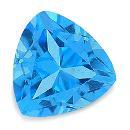|
|
||||||||||||||||
|
||||||||||||||||
|
||||||
|
|
|
|
Topaz
|
|
| | |
| Discovered in prehistory; IMA status: Valid (pre-IMA; Grandfathered) | ||
|
| ||
|
Chemistry |
|
|
| |
|
Al2SiO4(F,OH)3 | |
|
|
Aluminim Silicate Fluoride Hydroxide |
|
Molecular Weight: |
182.25 gm |
|
Composition: |
Aluminum |
29.61 % |
Al |
55.95 % |
Al2O3 |
|
|
Silicon |
15.41 % |
Si |
32.97 % |
SiO2 |
|
|
Hydrogen |
0.50 % |
H |
4.45 % |
H2O |
|
|
Oxygen |
43.02 % |
O |
|
|
|
|
Fluorine |
11.47 % |
F |
11.47 % |
F |
|
|
|
- % |
F |
-4.83 % |
-O=F2 |
|
|
|
100.00 % |
|
100.00 % |
= TOTAL OXIDE |
|
|
|
||||
|
Classification |
|
|
| |
|
Silicates (Germanates) | |
|
8/B.02-70 | |
|
|
9 : SILICATES (Germanates)
|
|
Related to: |
n/a |
|
Varieties: |
Imperial Topaz, Pyknite |
|
Color Variety Names: |
Champagne, Imperial, London Blue, Mystic, Sky Blue, Swiss Blue, |
|
Synonyms: |
Chrysolithos, Colorado Topaz, Physalite, Pyrophysalite, Silver Topaz, White Topaz |
|
|
|
|
Crystal Data |
|
|
|
|
|
Well-formed crystals common, typically morphologically complex, long to short prismatic, to 1.2 m. Prism faces commonly vertically striated, with etch and growth figures on non-prism faces; columnar, compact, massive. |
|
|
None |
|
|
|
|
|
Physical Properties |
|
|
|
|
|
Perfect on {001} |
|
|
Subconchoidal to Irregular/Uneven |
|
|
Brittle |
|
|
8.0 |
|
|
3.49 - 3.57 (g/cm3) |
|
|
Rarely Fluorescent; blue and colorless gems: weak yellow-green in LW UV, weaker in SW UV; sherry brown and pink gems: orange-yellow in LW UV, weaker in SW UV, sometimes greenish white in SW UV. |
|
|
Not Radioactive |
|
|
|
|
|
Optical Properties |
|
|
|
|
|
Colourless, white, pale blue, light green, yellow, yellowish brown, pink, red |
|
|
Transparent to Opaque with inclusions |
|
|
Vitreous |
|
|
1.606 - 1.644 Biaxial ( + ) |
|
|
0.0090 - 0.0110 |
|
|
Noticable; 0.0140; r > v |
|
|
Weak; X = yellow; Y = yellow, violet, reddish; Z = violet, bluish, yellow, pink |
|
|
|
|
|
Occurances |
|
|
|
|
|
Geological Setting: |
In veins and cavities in granite, granite pegmatite, rhyolite, and in greisen, formed from high-temperature, volatile-rich pneumatolytic hydrothermal fluids. From high-grade metamorphism of aluminous, quartz-rich, and fluorine-bearing sediments. As a heavy detrital mineral. |
|
Common Associations: |
Albite, Beryl, Cassiterite, Fluorite, Microcline, Quartz, Tourmaline, Zinnwaldite |
|
Common Impurities: |
None |
|
Type Locality: |
None (prehistoric) |
|
Year Discovered: |
Prehistoric |
|
View mineral photos: | |
|
|
|
|
More Information |
|
|
|
|
|
| |
|
|
|
|
Very large Topaz crystals have been found weighing hundreds of pounds. These crystals are often very gemmy and have produced faceted gems of up to 20,000 carats! Possibly the largest faceted gemstone in the world is a light blue Topaz (treated) from Brazil weighing 21,327 carats cut in an emerald shape called the Brazilian Princess. Many of the other colors of natural Topaz (yellow, orange, pink, red) are found as much smaller crystals. Natural orange Topaz is oftern called "Imperial" or "Precious" Topaz. There
are many locations worldwide where Topaz can be found.
A few locations for the finest specimens include near
Mursinka, Ural Mountains, Russia; the Skardu and
Gilgit districts, Pakistan; the Mogok district, Myanmar
(Burma); Ouro Preto, Minas Gerais, Brazil; Tepetate,
San Luis Potosi, Mexico; and in the USA at Ramona, San
Diego County, California; Devils Head, Douglas County,
Colorado; the Thomas Range, Juab County, Utah, USA. |
|
|
We
have not photographed our Topaz
yet. Please
check back soon. |
